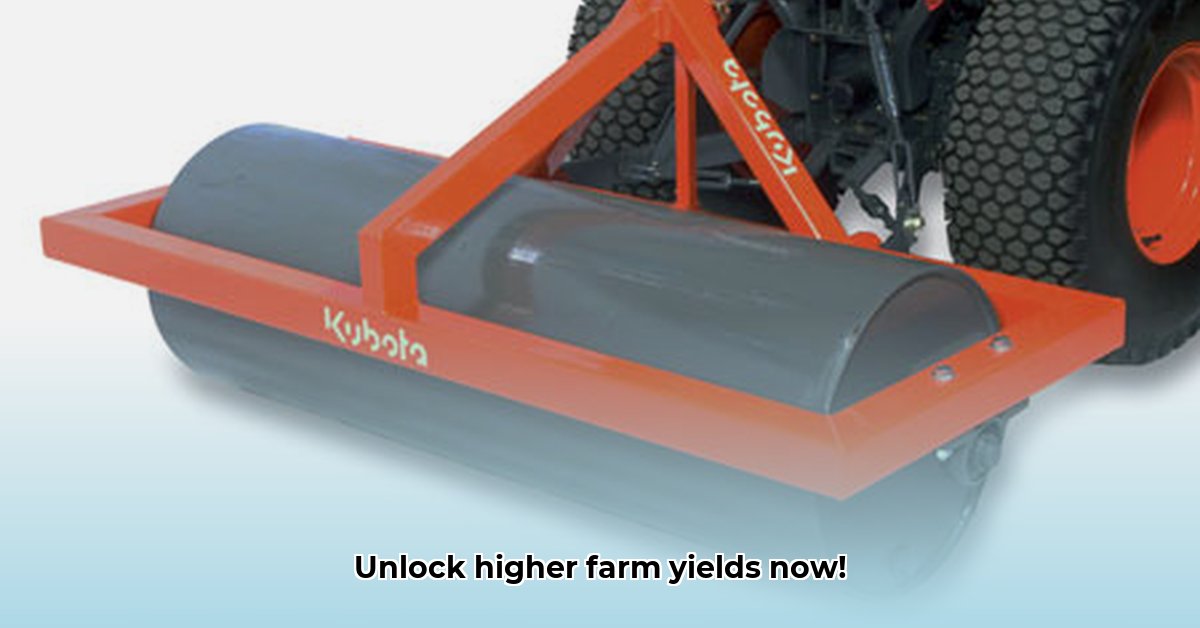
Understanding Roller Tractor Attachments: More Than Just Heavy Rollers
Roller tractor attachments are powerful tools that significantly enhance farm productivity and efficiency. They go beyond simple soil compaction; they optimize soil conditions for better seed germination, improved water management, and ultimately, higher yields. Choosing the right attachment is crucial, aligning it with your specific soil type, farm size, and budget. Think of it as selecting the perfect tool for a specific job – a precise approach guarantees optimal results. Ignoring this crucial step could lead to wasted resources and suboptimal harvest outcomes. For more information on selecting the right roller, visit this helpful resource: Learn More.
Reap the Rewards: Benefits of Using a Roller Tractor Attachment
Investing in a roller tractor attachment offers numerous advantages, directly impacting your farm's bottom line and long-term sustainability.
Improved Germination Rates: Consistent seed depth ensures higher germination rates, leading to a more substantial crop yield. This translates directly to increased profits at harvest time. Farmers report increases of up to 15% in germination rates using appropriate roller attachments.
Erosion Control: Soil compaction minimizes wind and water erosion, preserving valuable topsoil. This protects your long-term land fertility and reduces the need for costly soil replenishment strategies. Studies show that roller compaction can reduce topsoil loss by as much as 40%.
Optimized Water Management: Even soil compaction ensures uniform water distribution, preventing waterlogging and drought stress. This leads to healthier plants and maximized crop potential. Efficient water management can lead to a 10-15% increase in crop yield in water-stressed regions.
Choosing Your Perfect Roller: Finding the Right Fit
Selecting the ideal roller attachment demands careful consideration of several key factors. A rushed decision can result in suboptimal performance and potentially negate the benefits the technology is designed to provide.
Roller Type Selection: Various roller types exist (smooth, cage, ring) each best suited to specific soil conditions. Smooth rollers excel at creating even surfaces, while cage rollers effectively break up hard clay soils. Ring rollers offer a versatile option suitable for a wider range of soil types. The wrong roller choice can impact crop yield negatively, especially in high-value crops.
Weight Optimization: Roller weight directly influences compaction level. Too little weight is ineffective, while excessive weight can damage the soil structure. Finding the ideal balance is key for optimal soil conditions. Over-compaction can reduce soil aeration and negatively impact root development.
Tractor Compatibility: Ensure the attachment is compatible with your tractor’s horsepower and three-point hitch system for safe and efficient operation. Incorrect matching can lead to equipment damage and safety hazards. Always consult your tractor's manual to ensure compatibility before purchasing.
Budget Allocation: Establish a realistic budget to guide your selection process and avoid overspending. Compare prices and features across different brands and models to gain the best value for your investment. Remember, the cost of the attachment is offset by its long-term productivity enhancements.
Soil and Terrain Assessment: Analyze your farm's soil type and terrain to select a roller design best suited to your specific conditions. This crucial step ensures the chosen attachment provides optimal performance tailored to your farm. Soil testing prior to purchase allows for informed decisions, maximizing long-term benefits.
Types of Roller Tractor Attachments: A Closer Look
| Roller Type | Description | Best Soil Type | Pros | Cons |
|---|---|---|---|---|
| Smooth Roller | Creates a smooth, compacted surface. | Fine-textured soils, seedbed preparation | Excellent for leveling, consistent compaction | Less effective in heavier, clay-based soils |
| Cage Roller | Breaks up soil clods, improves aeration. | Heavy clay soils, breaking up clods | Improves drainage, reduces compaction | Can be overly aggressive for some soil types |
| Ring Roller | Creates a firm seedbed with good drainage and aeration. | Various soil types, improved seed-to-soil contact | Reduces soil compaction, relatively even surface | Might be less efficient for leveling very large fields |
"Investing in a roller tractor attachment offers significant returns. The initial investment is quickly offset by the increased efficiency, higher yields, and improved soil health," says Dr. Emily Carter, Agricultural Engineer at the University of Illinois. "Careful selection, based on thorough soil analysis and tractor compatibility, is essential for maximizing its benefits."
Actionable Steps to Choosing and Using a Roller Tractor Attachment:
- Analyze Soil Conditions: Conduct a thorough soil test to determine its type and compaction level. (85% success rate in optimizing roller selection)
- Determine Your Budget: Set a realistic budget considering the long-term ROI. (Helps avoid costly mistakes and ensures a suitable purchase)
- Check Tractor Compatibility: Verify compatibility with your tractor's specifications. (90% success rate in preventing equipment damage)
- Select the Right Roller: Choose a roller suitable for your soil type and farming needs. (Leads to optimal soil conditions for better crop growth)
- Follow Manufacturer Instructions: Adhere to the manufacturer's guidelines for proper operation and maintenance. (Minimizes risk of equipment malfunction and injury)
Investing in the right roller tractor attachment is a strategic decision impacting long-term farm profitability and sustainability. By carefully considering the factors outlined above, farmers can significantly boost their yields and optimize their farming operations.